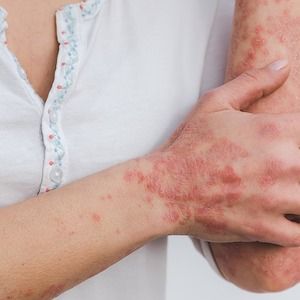News
Article
Unidirectional Association Identified Between Metabolic Syndrome, Hypertension as Risk Factors for Psoriasis
Author(s):
This new analysis identified several major psoriasis risk factors, highlighting the idea that early management of such factors might help to decrease both the risk and severity of the skin disease.

Metabolic syndrome (MetS), hypertension, and waist circumference (WC) are risk factors in psoriasis development, according to a recent analysis, indicating possible effectiveness of early management of MetS in diminishing the risk of psoriasis.1
The findings from this analysis examining some of the lesser-known modifiable risk factors of psoriasis, given that early intervention in other modifiable factors such as obesity and mental health can substantially reduce psoriasis incidence.2
Mendelian randomization (MR) is a method used here which employs resilient statistical methodology, utilizing genetic variants—specifically single-nucleotide polymorphisms or SNPs—to examine the underlying causal impacts of MetS and its constituents on the chronic skin disease.
This new Mendelian randomization analysis was authored by Xianhe Li, from the Department of Plastic Surgery at the Modern Hospital of Sichuan in China.
“At present, no study has been conducted to explore the causal association between psoriasis and MetS and its components,” Li and colleagues wrote. “Collectively, we conducted this bidirectional MR analysis to discover their causal links.”
Background and Findings
The investigators utilized comprehensive summary-level exposure datasets drawn from reputable GWAS public databases to examine the potential causality of the effects of MetS on psoriasis, as well as MetS’s components such as hypertension, waist circumference, triglycerides (TG), fasting blood glucose (FBG), and high-density lipoprotein cholesterol (HDL-C).
The GWAS datasets used in the research team’s work included data drawn from larger-sized participant populations, and these included 231,430 controls, 59,677 MetS cases, 463,010 hypertension subjects, 462,166 waist circumference samples, 441,016 TG samples, and 441,016 HDL-C samples. These were mainly sourced from the UK Biobank.
The investigators’ FBG dataset—which contained a total of 281,416 samples—was derived from meta-analyses taken from the glucose and insulin-related traits consortium.
The team incorporated information from the FinnGen study launched in Finland in 2017, harnessing genome data from 3,775 whole genomes and finding a total of 16,962,023 variants. Their extraction of summary-level outcome datasets for psoriasis from the FinnGen Biobank, included a total of 4,510 cases with psoriasis and 212,242 controls, with diagnoses being based upon the International Classification of Diseases criteria.
The investigators sought to ensure robustness, making use of instrumental variables (IVs) which they carefully identified to help meet specific criteria, including substantial association with exposure, no association with confounders, and exclusive impact on outcomes resulting from exposure.
In order to enhance their work’s statistical validity, the research team utilized various types of methodologies such as the MR-PRESSO approach to both identify as well as mitigate pleiotropy, F-statistic evaluation for study strength, and the random effects inverse variance weighting (re-IVW) technique as the major tool of analysis.
Several different sensitivity analyses—including weighted median, MR.RAPS, maximum likelihood, MR-Egger, and MR-PRESSO, were carried out to determine possible heterogeneity as well as pleiotropy, and Cochran's Q test was then utilized to assess variant-specific estimate heterogeneity.
The investigators’ methodological tool set also used a leave-one-out analysis to help confirm their results robustness at the removal of each of the IVs. A substantial threshold of Bonferroni-corrected P < 0.0041 was then set by the team for statistical assessments.
The research team noted that hypertension, MetS, and an increased circumference of the waist were all linked to a greater susceptibility to psoriasis. The odds ratios (OR) reported by the investigators for such associations were shown to be 1.17 (95% confidence interval [CI] 1.08 – 1.27, P = 1.23e - 04) for MetS, 1.65 (95% CI 1.42 – 1.93, P = 1.06e - 10) for waist circumference, and 2.02 (95% CI 1.33 – 3.07, P = 0.0009) for hypertension.
The team’s findings suggest a statistically significant link between these specific factors and the risk of patients developing the skin disease. However, when examining the relationship in the other direction, the investigators were unable to identify any evidence of a causal link between psoriasis and MetS or its individual components.
This suggests that while MetS, hypertension, and waist circumference may contribute to higher chances of developing psoriasis, the reverse was shown not to hold true, indicating a unidirectional association.
“The current study was conducted on populations of European ancestry, which leads to the difficulty in applying the findings to other races,” they wrote. “Moreover, there is a huge quantity variation between cases and controls in outcome datasets. In future studies, replication in other ethnicities and large studies with more samples should be performed to verify the conclusions.”
References
- Liu, L, Wang, W, Si, Y, Li, X. Genetic insights into the risk of metabolic syndrome and its components on psoriasis: A bidirectional Mendelian randomization. J Dermatol. 2023; 00: 1–9. https://doi.org/10.1111/1346-8138.16910.
- Takeshita J, Grewal S, Langan SM, Mehta NN, Ogdie A, van Voorhees AS, et al. Psoriasis and comorbid diseases: epidemiology. J Am Acad Dermatol. 2017; 76: 377–390.
- Semenov YR, Herbosa CM, Rogers AT, Huang A, Kwatra SG, Cohen B, et al. Psoriasis and mortality in the United States: data from the National Health and Nutrition Examination Survey. J Am Acad Dermatol. 2021; 85: 396–403.





